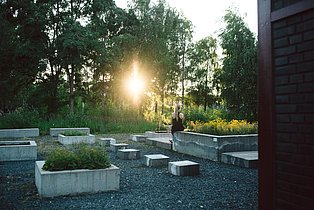
In this “Färbergarten” (Dyer's garden) various dye plants grow around the former signal box. Dyes can be made from their flowers, leaves, fruits, roots and barks.
The production of one's own dyes from crushed, mortared and squeezed plant parts follows craft traditions that people from all cultural circles have mastered for thousands of years. This art has almost fallen into oblivion with the advent of synthetic dyes with the development of coal chemistry in the mid-19th century. Here in the dyer‘s garden, this knowledge is to revive.
The path from plant to colour draws attention to the cycles in nature and enables learning with all the senses. This combines cultural education, education for sustainable development and environmental education. During the summer months, the Ruhr Museum offers workshops for young and old.
The Zollverein Färbergarten is a cooperation project between the Zollverein Foundation, the global network initiative sevengardens and the Ruhr Museum.
You can find out how and with what you can best get to us and our locations here.